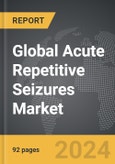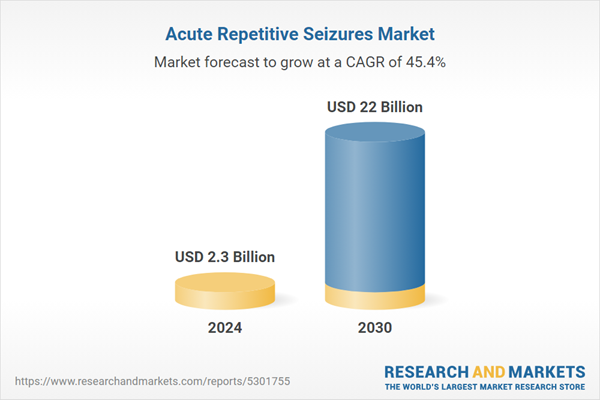Global Acute Repetitive Seizures Market - Key Trends and Drivers Summarized
Why Are Acute Repetitive Seizures a Critical Concern in Epilepsy Management?
Acute repetitive seizures (ARS), also known as cluster seizures, represent a significant and often urgent concern in the management of epilepsy. But why are these seizures so critical? ARS refers to a situation where a person experiences multiple seizures within a short period, typically within 24 hours, without fully regaining consciousness between episodes. This condition can lead to a life-threatening escalation into status epilepticus, a prolonged seizure state that requires immediate medical intervention. For individuals with epilepsy, ARS is unpredictable and poses serious health risks, including brain damage, injury from falls, and other complications. ARS is particularly concerning because it can occur even in people whose epilepsy is otherwise well-managed with medication. This unpredictability increases the burden on patients, caregivers, and healthcare providers, as timely and effective intervention is crucial to prevent the escalation of these seizure clusters. Despite its severity, ARS remains under-recognized, and its management is an area of ongoing concern in neurology.Where Is the Impact of Acute Repetitive Seizures Most Profound?
The impact of acute repetitive seizures is most profoundly felt in individuals with drug-resistant epilepsy or those who have frequent, uncontrolled seizures. ARS can lead to serious medical complications if not treated promptly, and its effects are seen across multiple domains of a patient's life. In pediatric epilepsy, children who experience ARS are at a higher risk for developmental delays, cognitive impairment, and emotional disturbances due to the frequent and severe nature of their seizures. This can significantly affect their quality of life, as frequent hospitalizations or the need for emergency medical interventions disrupt schooling, social interactions, and overall development. The impact is also substantial in adults, particularly those with refractory epilepsy who are unable to maintain seizure control with standard medications. For these individuals, ARS often means recurrent visits to emergency departments, leading to increased healthcare costs and a diminished quality of life. Beyond the direct health implications, ARS also affects caregivers and families. The need for constant vigilance and the fear of unpredictable seizure clusters adds considerable stress to the lives of those caring for individuals with epilepsy. In some cases, the social and emotional toll of ARS can lead to caregiver burnout, financial strain due to medical expenses, and difficulties in managing daily activities. Additionally, the occupational and educational prospects of those affected by ARS are often hindered, as the risk of sudden seizures can limit their ability to participate in work, school, and social environments. In this context, the far-reaching impact of ARS underscores the need for better management strategies and greater awareness of the condition.What Innovations Are Shaping the Future of Acute Repetitive Seizures Management?
Innovations in the management of acute repetitive seizures are focused on improving both the speed and efficacy of treatment interventions. Traditionally, treatments for ARS were limited to emergency care settings, where intravenous administration of anticonvulsants such as benzodiazepines was the primary method of control. However, recent advancements have led to the development of more patient-friendly, fast-acting treatments that can be administered outside of the hospital setting, allowing for quicker intervention. One of the most significant innovations in this area is the introduction of nasal and buccal (inside the cheek) formulations of rescue medications, such as diazepam and midazolam. These non-invasive treatments can be administered by caregivers or patients themselves, providing a critical window of time to stop the progression of seizures before they escalate into more severe episodes like status epilepticus. This has revolutionized the management of ARS by enabling rapid treatment in home or community settings, reducing the need for emergency room visits. Another key advancement is the development of wearable and connected technologies that can detect seizure patterns and provide early warning signs of ARS. Devices like smartwatches and EEG-based systems can monitor physiological signals, such as heart rate or brainwave activity, to alert patients and caregivers of impending seizure clusters. These early detection systems not only improve response times but also offer valuable data for healthcare providers to better understand seizure patterns and optimize long-term treatment plans. Additionally, ongoing research in the field of epilepsy is exploring novel drug therapies and genetic treatments that could offer more targeted approaches to preventing ARS. For example, some studies are investigating the potential of gene therapy to address the underlying causes of drug-resistant epilepsy, which could drastically reduce the incidence of ARS.What Factors Are Driving the Focus on Acute Repetitive Seizures Treatment?
The focus on improving the treatment of acute repetitive seizures is driven by several critical factors that reflect the broader challenges in epilepsy management. One of the most pressing drivers is the need to reduce the medical and socioeconomic burden associated with ARS. Repeated emergency room visits, hospitalizations, and the need for intensive medical intervention contribute to significant healthcare costs, both for families and healthcare systems. As epilepsy is one of the most common neurological conditions worldwide, with millions of people affected, the cost of unmanaged ARS is substantial. Another key driver is the push for better patient-centered care. Individuals with epilepsy and their caregivers often experience high levels of anxiety and stress due to the unpredictability of ARS. This unpredictability can severely limit daily activities, social participation, and overall quality of life. As a result, there is increasing demand for treatments that are not only effective but also easy to administer and allow patients to regain control over their condition. The availability of at-home rescue medications and early-warning systems directly addresses this need, empowering patients and caregivers to take timely action and avoid unnecessary emergency interventions. Furthermore, regulatory and healthcare organizations are increasingly recognizing the importance of addressing gaps in epilepsy care, particularly in the treatment of ARS. Guidelines from major health bodies, such as the American Epilepsy Society and the International League Against Epilepsy, have highlighted the need for rapid-response treatments that can be used in non-clinical settings. This has prompted pharmaceutical companies to invest in the development of new rescue therapies and technologies aimed at managing ARS more effectively. In addition, advancements in understanding the neurobiology of epilepsy are driving research into more targeted therapies that could prevent ARS from occurring in the first place. These factors, combined with the broader movement towards improving quality of life for individuals with epilepsy, are driving the growing focus on finding innovative and effective solutions for the management of acute repetitive seizures.Report Scope
The report analyzes the Acute Repetitive Seizures market, presented in terms of market value (US$ Thousand). The analysis covers the key segments and geographic regions outlined below.- Segments: Product (Diastat Rectal Gel, USL-261, NRL-1, Other Products).
- Geographic Regions/Countries:World; United States; Canada; Japan; China; Europe (France; Germany; Italy; United Kingdom; Spain; Russia; and Rest of Europe); Asia-Pacific (Australia; India; South Korea; and Rest of Asia-Pacific); Latin America (Argentina; Brazil; Mexico; and Rest of Latin America); Middle East (Iran; Israel; Saudi Arabia; United Arab Emirates; and Rest of Middle East); and Africa.
Key Insights:
- Market Growth: Understand the significant growth trajectory of the Diastat Rectal Gel segment, which is expected to reach US$8.4 Billion by 2030 with a CAGR of a 46.9%. The USL-261 segment is also set to grow at 43.1% CAGR over the analysis period.
- Regional Analysis: Gain insights into the U.S. market, valued at $577.4 Million in 2024, and China, forecasted to grow at an impressive 52.8% CAGR to reach $6.3 Billion by 2030. Discover growth trends in other key regions, including Japan, Canada, Germany, and the Asia-Pacific.
Why You Should Buy This Report:
- Detailed Market Analysis: Access a thorough analysis of the Global Acute Repetitive Seizures Market, covering all major geographic regions and market segments.
- Competitive Insights: Get an overview of the competitive landscape, including the market presence of major players across different geographies.
- Future Trends and Drivers: Understand the key trends and drivers shaping the future of the Global Acute Repetitive Seizures Market.
- Actionable Insights: Benefit from actionable insights that can help you identify new revenue opportunities and make strategic business decisions.
Key Questions Answered:
- How is the Global Acute Repetitive Seizures Market expected to evolve by 2030?
- What are the main drivers and restraints affecting the market?
- Which market segments will grow the most over the forecast period?
- How will market shares for different regions and segments change by 2030?
- Who are the leading players in the market, and what are their prospects?
Report Features:
- Comprehensive Market Data: Independent analysis of annual sales and market forecasts in US$ Million from 2024 to 2030.
- In-Depth Regional Analysis: Detailed insights into key markets, including the U.S., China, Japan, Canada, Europe, Asia-Pacific, Latin America, Middle East, and Africa.
- Company Profiles: Coverage of players such as Alexza Pharmaceuticals, Bausch Health, Neurelis, Pfizer Inc., Sanofi and more.
- Complimentary Updates: Receive free report updates for one year to keep you informed of the latest market developments.
Some of the 36 companies featured in this Acute Repetitive Seizures market report include:
- Alexza Pharmaceuticals
- Bausch Health
- Neurelis
- Pfizer Inc.
- Sanofi
- UCB S.A.
- Valeant Pharmaceuticals North America LLC.
- Veriton Pharma
This edition integrates the latest global trade and economic shifts into comprehensive market analysis. Key updates include:
- Tariff and Trade Impact: Insights into global tariff negotiations across 180+ countries, with analysis of supply chain turbulence, sourcing disruptions, and geographic realignment. Special focus on 2025 as a pivotal year for trade tensions, including updated perspectives on the Trump-era tariffs.
- Adjusted Forecasts and Analytics: Revised global and regional market forecasts through 2030, incorporating tariff effects, economic uncertainty, and structural changes in globalization. Includes historical analysis from 2015 to 2023.
- Strategic Market Dynamics: Evaluation of revised market prospects, regional outlooks, and key economic indicators such as population and urbanization trends.
- Innovation & Technology Trends: Latest developments in product and process innovation, emerging technologies, and key industry drivers shaping the competitive landscape.
- Competitive Intelligence: Updated global market share estimates for 2025, competitive positioning of major players (Strong/Active/Niche/Trivial), and refined focus on leading global brands and core players.
- Expert Insight & Commentary: Strategic analysis from economists, trade experts, and domain specialists to contextualize market shifts and identify emerging opportunities.
Table of Contents
Companies Mentioned (Partial List)
A selection of companies mentioned in this report includes, but is not limited to:
- Alexza Pharmaceuticals
- Bausch Health
- Neurelis
- Pfizer Inc.
- Sanofi
- UCB S.A.
- Valeant Pharmaceuticals North America LLC.
- Veriton Pharma
Table Information
| Report Attribute | Details |
|---|---|
| No. of Pages | 180 |
| Published | December 2025 |
| Forecast Period | 2024 - 2030 |
| Estimated Market Value ( USD | $ 2.3 Billion |
| Forecasted Market Value ( USD | $ 22 Billion |
| Compound Annual Growth Rate | 45.4% |
| Regions Covered | Global |







